The Red Factor Canary
The Red Factor Canary belongs to the "Color" canary (or "Colorbred") canary Type.
Color canaries are one of the...
Three Types of Canaries--->
1. Type
2. Song
3. Colorbred
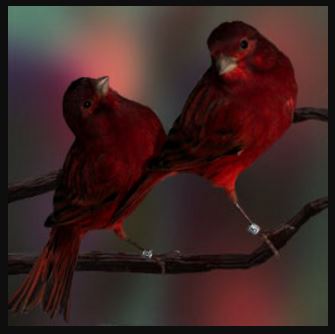 Red Factor Canaries
Red Factor CanariesThe Colorbred is a type of canary that has been bred to bring a specific desired color with little or no regard for singing ability or body shape. There are many colors but the Red Factor canary is the most popular and the most well known.
Any canary with a red factor gene can be referred to as a "red factor".
Keep in mind though that within this colorbred group there are many different colors and shades of red.
Through selection of color mutations AND "intensive breeding" breeders have discovered many colors.
FREE Email Course.
Sign up below and get the 5 part email course: "The #1 Problem You Will Face As A Canary Owner"
Recommended Pet Canary Supplies...
A Rainbow Of Colors.
Some of the colors you will see exhibited at a Colorbred canary show are...
- White
- Blue
- Fawn
- Yellow
- Green
- Brown
- Silver
- Gold
- Rose
- Bronze
- Mosaic
- Orange
- And a WHOLE lot more
and, of course, the most popular Color...
- Red --Sometimes referred to as the "Red Factor Canary" or just "Red Canary".
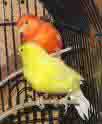 Red factor canary and a yellow
Red factor canary and a yellowRed Factor Canary
By far the most well known of the colorbred canaries is the red canary.
This color canary was developed in the early 1900's by crossing a Venezuelan Black-Hooded Red Siskin with a yellow canary. Some say the yellow canary was a German Roller while others say it was a Border...I guess no one knows for sure.
Everyone pretty much agrees it was a yellow canary though...it's nice to agree on something...:-)
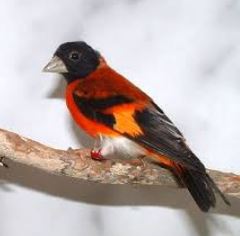 red hooded siskin
red hooded siskinThis pairing of a canary and a Venezuelan Black-Hooded Red Siskin resulted in a couple of...
Controversies...
1. The Venezuelan Black-Hooded Red Siskin is not a canary at all. So is the offspring a canary?
---My KNEE-JERK reaction:---
"Who cares?"
To the average canary owner it doesn't matter. You have a beautiful bird. There is someone who cares though...
Breeders and Exhibitors.
It's difficult to have a canary show if half the birds are not "pure-bred" canaries.
Today's red canary offspring is more canary than Siskin--I will say that.
The Siskin is in the mix just to get a start in the development of red canaries. The first offspring of that initial pairing were then bred to other canaries...
...and those to other canaries...
...and those to other canaries...
...and on and on and on...
The level of Siskin blood is virtually gone by now. So...the real answer is...
Yes...the red factor canary is indeed a canary.
2. In order for these canaries with the red factor to actually be red, special foods must be provided which are absorbed by the canary's system and results in red feathers.
See Red Intensive Supplement and Red Eggfoods.
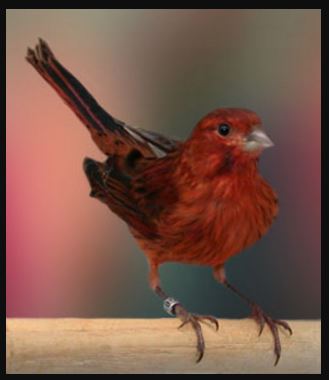 Red Factor Canary
Red Factor CanaryUnnatural Reds
At one time way back in the "old days" of canary exhibition there was some controversy over the red canary.
Red canaries were not allowed to be shown if they had been fedconcentrates of carotenoids--they were considered unnatural--See "Color Fed" below.
But they soon came to their senses and realized there was no way to enforce such a ruling. Besides...
The rule was inconsistent with other feeding routines.
Breeding pairs are often fed boiled egg for a protein supplement...boiled egg is definitely NOT a natural food source for canaries.
How many different canary colors are there?
Over 200 Canary Color Variations
Breeders who specialize in the Colorbred canary are
veritable experts at canary
genetics. Studying such topics as
- cells, chromosomes, and genes
- Recessive and dominant traits
- Homozygous and Heterozygous pairings
...and other such high-falutin' sounding words.
Me? I know nothing about genetics AND if you want to keep a red factor canary as a pet...
YOU don't need to know all that stuff either.
I created CanaryAdvisor.com for the serious pet canary owner (not the breeder) to help insure that your bird stays healthy and happy so that you can enjoy him for as long as possible.
The study of canary genetics is for the serious canary breeder and exhibitor not the average pet owner.
Mules
When breeding those original Canary-Siskin crosses only a small percentage of the offspring were fertile...typical when...
Crossing Two Breeds.
- Breed a donkey and a horse and you end up with a mule that is sterile...
- Breed a siskin or any other bird with a canary and you get mule canaries of which MOST are sterile.
Like I said I'm not "into" genetics so I won't go into detail.
As I mentioned above, to bring out that pretty red coloring these canaries must be...
Color Fed.
The Venezuelan Black-Hooded Red Siskin obtains it's brilliant red coloring by eating foods high in carotenoids.
Take a Siskin out of his natural habitat and feed him foods devoid of carotenoids and you end up with little or no red in the Red Siskin...IRONIC ISN'T IT?
It's a similar story with the PINK Flamingo. They obtain their color from the plankton they feed on in the wild.
Take them out of the wild where they have no access to that plankton and they are as white as the background on this page.
"White Flamingo" -->just doesn't have the same ring to it...;-)
I understand zoos feed their Flamingos beet juice so they will obtain the pink coloring. Interesting...I just can't figure out how they get the Flamingos to drink beet juice. YUCK!
It's the same with canaries. Check out these red mosaics...
A red factor canary will get some color from natural foods that you supply...
- greens
- Red peppers
- sweet potatoes
- squashes
- tomatoes
- beets
- cayenne pepper
- paprika
- berries
- cherries
These foods, fed regularly, will help your red factor canary maintain an orange to reddish hue. To get a really nice deep red however, you'll want to use a...
Concentrate of Carotenoids.
You can buy a mix that should be added to water or food.
You must have a red factor canary for this to work. Color feeding would have little or no effect on common canaries.
This mix is a concentrate of Canthaxanthin and Beta-Carotene. For best results get a concentrate that has BOTH Canthaxanthin AND Beta-Carotene--not just one.
Some have sugar additives of sucrose, dextrose, as well as vitamin C and vitamin B but these FILLERS don't help with the coloring. They only dilute the mix. Try to buy pure concentrate to get your moneys worth.
It has been said that feeding these concentrates year-round will cause health problems including liver and kidney damage to your red factor canary but I've known breeders that use concentrates all the time, year-round, and have never had any problems. Just follow the directions on the box and you and your red factor canary will be fine.
Feed these foods and concentrates immediately before and during the molt. All new feathers will come in red. You can continue to feed carotenoids to your red factor canary after the molt so that if a feather is lost and re-grown it will also grow-in red.
Without the intensive red supplements and foods, your red factor canary might still get some color. But it'll less rich and probably orange-ish.
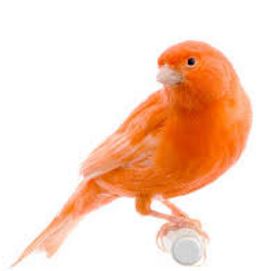 Orange Red Canary
Orange Red Canary
|
Return from Red Factor Canary to Canary Types.
Have A Great Story or Tip About This Topic?
Do you have a great story or tip about canary health care? Share it! It may be of great interest and assistance to other canary owners.











